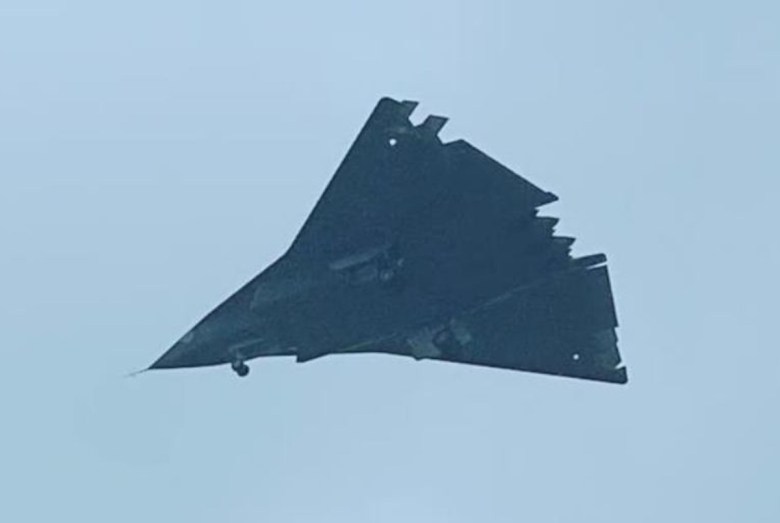Top Stories
China’s J-36 Prototype Accelerates Air Dominance Race with US

China is rapidly advancing its military aviation capabilities, highlighted by the emergence of the new J-36 prototype, which aims to outpace United States developments in next-generation air dominance. Recent reports indicate that images shared on Chinese social media depict a second prototype of this large three-engine stealth aircraft, unofficially named the J-36. This prototype was observed taking flight near the military-industrial hub of Chengdu, approximately ten months after the initial airframe was revealed in December 2024.
The latest J-36 prototype showcases substantial modifications, including redesigned air intakes, a re-engineered landing gear system, and an updated exhaust configuration. While it retains the delta wing design and side-by-side cockpit of the previous model, it shifts from recessed exhausts, which minimize infrared signatures, to a new thrust-vectoring system resembling that of the US F-22. This change suggests a trade-off between stealth and increased maneuverability, particularly at high angles of attack.
Ongoing aerodynamic enhancements characterize the J-36’s development, as indicated by its new diverterless supersonic inlets and the transition from tandem to side-by-side landing gear. These changes are likely intended to improve the aircraft’s ground handling, internal volume, and airflow stability. The rapid progression of this prototype reflects China’s ambition to create a long-range air superiority platform capable of controlling unmanned assets, aligning with US Air Force assessments that categorize the J-36 as a potential sixth-generation aircraft.
Although the specifications of the J-36’s engines remain uncertain, speculation suggests that it may be powered by WS-10 engines during testing, with plans for an advanced WS-15 engine to follow. The speed at which this prototype has evolved is uncommon in modern fighter development, where changes typically unfold over several years rather than months.
Air Vice-Marshal James Beck of the Royal Air Force remarked that fifth-generation fighters have become the baseline for achieving air superiority, even against basic threats. Despite this, many air forces, including those of the US and China, continue to operate fourth-generation aircraft, which provide numerical depth and cost-effectiveness. Beck highlighted the challenges of penetrating heavily defended airspace, as demonstrated in the ongoing Russia-Ukraine conflict, suggesting that sixth-generation fighters may soon be necessary.
These advanced jets are expected to incorporate artificial intelligence, operate alongside autonomous combat drones, and exhibit enhanced stealth, range, and combat effectiveness. Beck cautioned that the development of such aircraft should be a gradual process, ideally spanning decades. Yet, China’s swift rollout of next-generation fighters appears to challenge this notion.
China’s strategy may hinge on the belief that disruptive technologies can mitigate conventional disadvantages, allowing for a leapfrogging approach in military capabilities. By investing in radical innovations and bypassing older systems, China aims to redefine operational concepts and gain strategic advantages in conflict scenarios. Rather than matching the US in terms of aircraft numbers, China’s accelerated development of sixth-generation fighters could yield substantial qualitative improvements.
Despite China’s advancements, US fifth-generation fighters are undergoing continuous upgrades to maintain their effectiveness until the Next Generation Air Dominance (NGAD) program becomes fully operational. Reports from The War Zone indicate that the F-22 is currently undergoing a comprehensive upgrade under the “F-22 Capability Pipeline,” ensuring its viability through the 2030s. Key enhancements include integrating the AIM-260 Joint Advanced Tactical Missile, improved electronic warfare systems, and advanced sensors designed to counter evolving threats.
Similarly, plans are in place to transform the F-35 into a “5th-generation plus” platform, integrating new technologies from Lockheed Martin’s previous NGAD bid. This initiative aims to deliver 80% of sixth-generation capabilities at half the cost, emphasizing adaptability through advanced stealth materials, geometries, countermeasures, and enhanced sensors for superior situational awareness.
The US has opted for a strategy of opacity, conducting classified flights of NGAD prototypes since as early as 2019, prior to any public disclosures. Christian Orr, writing for the National Security Journal, noted that these demonstrators were developed in secrecy to maintain an edge over China’s future fighter capabilities.
Nevertheless, while the US continues to improve its fifth-generation aircraft, China’s production advantages may pose a significant challenge. Brandon Weichert highlighted in an article for The National Interest that despite the US possessing the world’s largest fleet of fifth-generation fighters, with 185 F-22s and around 400 F-35s, China is believed to have over 300 J-20s and aims for a production rate capable of producing a new aircraft every eight days.
Weichert emphasized the potential for China to surpass the F-35 fleet within two to three years, given the US’s relatively low production rate of 140 aircraft annually. He also pointed out that the geographic distribution of US aircraft could limit their effectiveness, while China could concentrate its airpower within the strategically significant First Island Chain.
Recent reports from Breaking Defense indicate an urgent call from the US Air Force to expand its fighter fleet, citing insufficient inventory levels to meet global demands amid rising threats from China and Russia. Currently, the US Air Force operates only 45 fighter squadrons, a significant reduction from 134 during the Cold War. The report advocates for a blend of upgraded legacy systems and next-generation platforms like NGAD and Collaborative Combat Aircraft to restore both numerical and technological superiority.
In summary, while the US maintains certain technological advantages, the rapid development of China’s J-36 and its broader military aviation capabilities may reshape the landscape of air dominance in the coming years. If the US does not adapt swiftly to these changes, the next generation of airpower may emerge from Asia rather than America.
-

 Lifestyle3 months ago
Lifestyle3 months agoHumanism Camp Engages 250 Youths in Summer Fest 2025
-

 Sports3 months ago
Sports3 months agoDe Minaur Triumphs at Washington Open After Thrilling Comeback
-

 Business4 months ago
Business4 months agoKenvue Dismisses CEO Thibaut Mongon as Strategic Review Advances
-

 Sports4 months ago
Sports4 months agoTupou and Daugunu Join First Nations Squad for Lions Clash
-

 Top Stories4 months ago
Top Stories4 months agoColombian Senator Miguel Uribe Shows Signs of Recovery After Attack
-

 World4 months ago
World4 months agoASEAN Gears Up for Historic Joint Meeting of Foreign and Economic Ministers
-

 Business4 months ago
Business4 months agoOil Prices Surge Following New EU Sanctions on Russia
-

 Entertainment3 months ago
Entertainment3 months agoDetaşe-Sabah Violin Ensemble Captivates at Gabala Music Festival
-

 Health3 months ago
Health3 months agoNew Study Challenges Assumptions About Aging and Inflammation
-

 Entertainment3 months ago
Entertainment3 months agoBaku Metro Extends Hours for Justin Timberlake Concert
-

 Business4 months ago
Business4 months agoU.S. House Approves Stablecoin Bill, Sends to Trump for Signature
-

 Top Stories4 months ago
Top Stories4 months agoRethinking Singapore’s F&B Regulations Amid Business Closures









